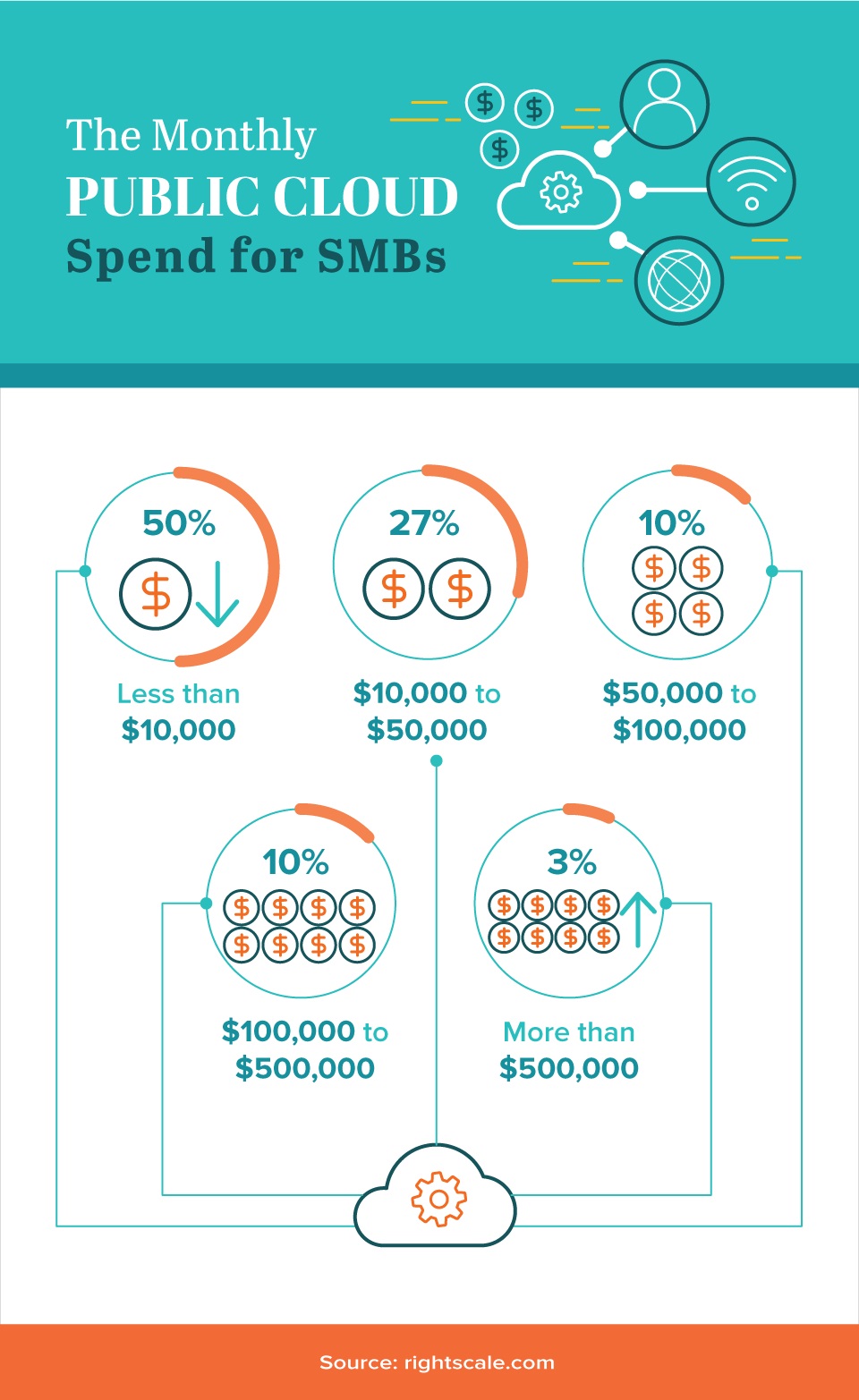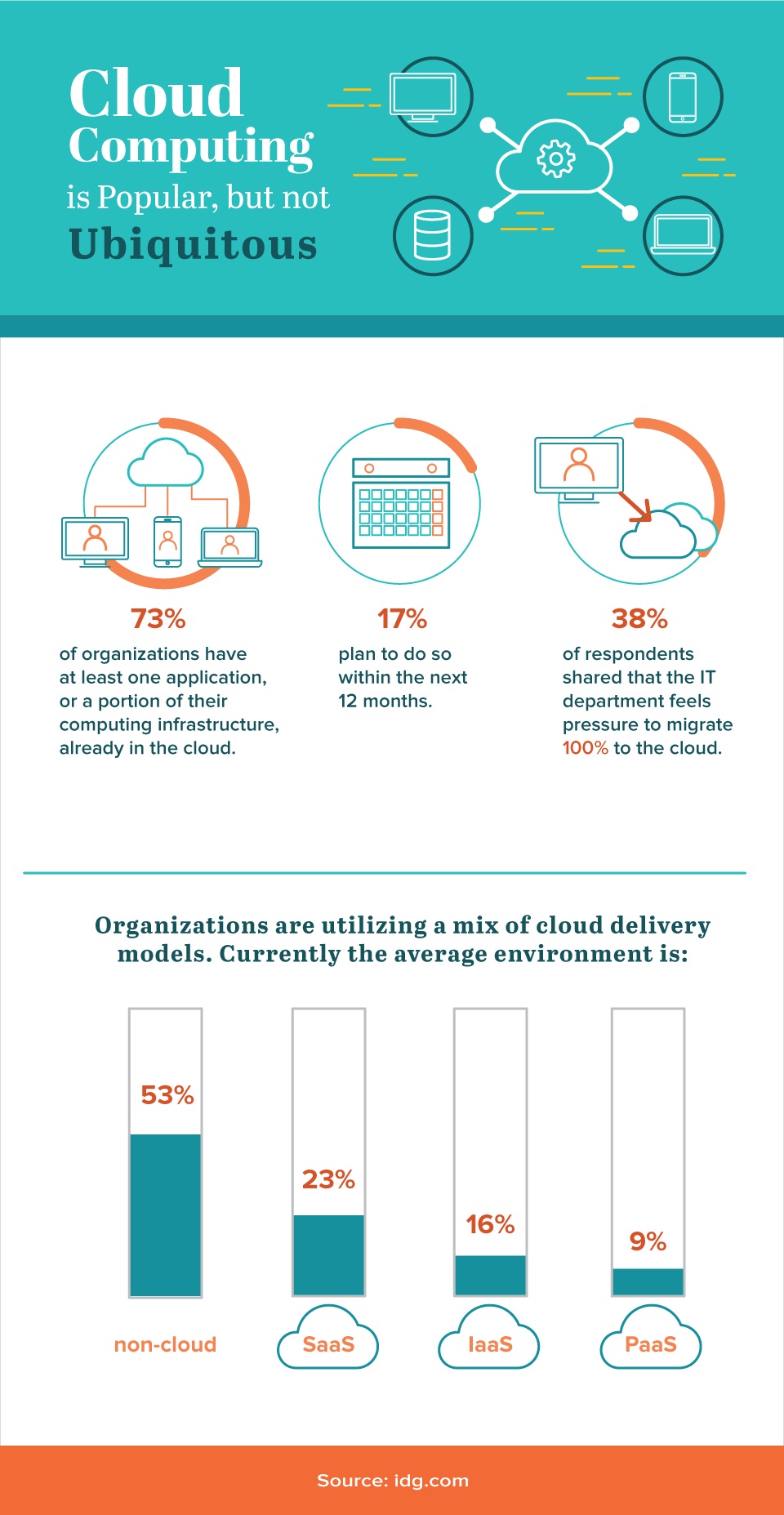It's impossible to talk about optimizing business today without making cloud computing a big part of the conversation. This makes the cloud big business: Worldwide spend on public cloud services and infrastructure is expected to reach $266 billion in 2021, according to IDC. The cloud can enable more efficient use of resources in nearly every aspect of business, from the underlying technical infrastructure that supports the entire operation to snazzy mobile applications that make life easier for marketing.
Large enterprises have been leveraging the benefits of cloud computing for years. Now that the cloud is becoming commoditized and more easily accessible, small and midsize businesses (SMBs) want to realize those same returns. It can be hard, however, to read through the hype to understand exactly what the cloud is, what it can do for your business, and how you can implement a strategy around it.
What is the cloud, anyway?
With traditional IT infrastructure, an organization's data and processes are all housed in an internal network. All of its data is stored either in a server that the business owns and that usually resides on its own premises, or in a server at a data center that is offsite and managed by a third party, but still local and dedicated only to that organization. Any applications, such as a CRM, accounting platforms, or office applications like word processing and email, are stored in these local servers, and the business's processes all run on this network. It's a closed, private, proprietary loop.
Cloud computing uses the internet to open that loop so users can house data, provide processing power, and run applications on a server where they essentially rent rather than own space. Programs live in the cloud, which is really just another giant server farm somewhere that's connected to local users through the net, like AWS or Microsoft Azure. That means organizations don't have to manage their own storage and power, can access applications from anywhere and at any time, and only pay for what they use.
One example of how cloud computing benefits businesses is with cloud-based POS systems. According to Lori Fairbanks, "cloud-based systems offer convenience, allowing you to access back-office features from any browser, which means that you can view your store's sales performance and run reports wherever you are." That convenience means business owners can be immediately up to speed on sales, inventory, and other data without interrupting workflows or even stepping foot inside the store.
The implications of these capabilities on business are broad and deep. Gartner predicts that half of global enterprises using the cloud now will become cloud-only operations by 2021 because of the advantages it holds for operations – advantages enjoyed by organizations with deep pockets for years, and which are finally becoming accessible to the SMB.
Where do you fall in the stack?
There are, generally speaking, three layers of cloud applications: infrastructure as a service (IaaS), platform as a service (PaaS) and software as a service (SaaS). When people talk about "moving up the stack," they're referring to these three elements.
Let's start at the top of the stack with SaaS. Similar to traditional, on-premise software, cloud-based applications still run on servers, just in the cloud, so they are accessible via the public network by anyone with a subscription. These are set-and-forget applications that companies don't have to worry about managing, and that in most cases can be used on a pay-as-you-go model rather than for an upfront cost. Salesforce, Office 365 and Dropbox are all good examples of commonly used SaaS applications.
Moving down the stack, we come to PaaS. Broadly, this is where software applications are built and deployed. If you're buying a PaaS offering, you're paying a provider to deal with most of the servers, operating systems and network infrastructure so you can just focus on the development of the actual business application. Think Heroku and Google Apps when you think of PaaS providers.
IaaS is the bottom, most foundational layer of the stack. This is where the most fundamental elements of computing reside, such as servers, storage, hardware and networking. Organizations that want to develop the entire application themselves look to IaaS providers to provide these elements, along with the security and ongoing maintenance they require. There is an IaaS provider for just about every use case out there. Navisite and Softlayer are just two of the more popular offerings.
What are some pros and cons of cloud services?
The pay-as-you-go nature of cloud computing gives us most of what is so transformative about it. But as much of a game-changer as the cloud has the potential to be, it's important to take all of those stratospheric value propositions with a grain of salt. Like anything, moving operations to the cloud requires research, planning and a comprehensive change management strategy. Yes, the benefits can be significant and immediate, but if executed poorly, the disadvantages can cause damage.
Short- vs. long-term affordability
Since organizations don't have to build and support their own IT infrastructure, they save a great deal of money on the front end. But it's important to understand that cloud computing isn't always the least expensive option. Remember that cloud spend is essentially renting storage and computing space on a third party's server. The more you access it, the more it will cost. For applications that an organization needs frequent and regular access to, it may very well be cheaper to build and maintain them in-house.
You must also take into account the costs that can come with migrating applications from an on-premise server to the cloud. Newer, "born in the cloud" applications are purpose-built to operate and scale horizontally in a public cloud model. But many legacy applications just weren't built for a cloud world. These apps require a customized, resource-intensive effort to get the legacy app and the cloud architecture to play well together. If you don't adequately plan for such an undertaking, the unexpected costs that come along with migrating to the cloud can be a major budgetary concern.
The key is to research your options and weigh them against your budget. After all, what's right for one SMB may be a poor fit for your business, and vice versa.
Agility vs. security
Because organizations that use cloud computing don't have to invest heavily in the underlying infrastructure required to build out projects or proofs of concept, they can spin up new capabilities much faster and more inexpensively. If the application is a dud, there's little lost in terms of IT spend. And if it's a hit, a company can very easily scale to accommodate demand, since the cloud provider is handling all of the resource-intensive parts of the operation.
This agility is only possible because the underlying infrastructure is shared among the cloud provider's customers. That means you're sharing storage space, operating systems and security protocols with potential competitors. If you aren't comfortable with that idea, or have concerns about trusting a cloud provider with your proprietary data, a public cloud solution might not be for you.
From a security perspective, the cloud can make spinning up and accessing applications too easy. With traditional, on-premise infrastructure, most IT spend goes through the IT department. In the age of "there's an app for that," employees and managers can often procure and implement third-party applications without going through IT. These "shadow apps," therefore, aren't subject to the same standard of security measures as the rest of an organization's processes.
How to take your first steps toward the cloud
If you investigate cloud services for your SMB and find it to be a worthwhile endeavor, you need a plan for implementation. Like any fundamental change to the business, a strategy for moving toward being a cloud-based business should be taken in steps. If you start down the cloud road without a clear understanding of your existing infrastructure cost and anticipated future needs, you may wind up costing yourself more than the cloud can save you.
- Evaluate your current position. There's more to IT spend than meets the eye. You need to account for what you spend running your server or renting space in a data center, the cost of the actual hardware, and how much you spend on mission-critical applications. Otherwise, it's impossible to calculate whether it's more cost-effective to buy and manage an application outright or procure it on a subscription basis in the cloud.
- Establish priorities. Don't get sucked into thinking you have to move the entirety of your operations to the cloud all at once. A good rule of thumb is to start with applications your operations depend on least in order to get a real-world feel for how processes work and are billed in the cloud. Cloud-based backups are a good jumping-off point too, since the actual day-to-day running of the business isn't dependent upon backup and disaster recovery applications.
- Make sure your people are equipped. Compared to the shift that people and processes have to make, the technology part of a cloud migration is easy. Will your employees' job functions change? Do they need additional training? Make sure you have a change management strategy in place for your people.
The expensive pieces of hardware and software necessary to run sophisticated business applications are now within reach of the SMB. This is the real beauty of cloud computing: It helps even the playing field. With research, deliberation and a little faith, SMB owners can put enterprise-grade solutions to work bettering their own businesses.



